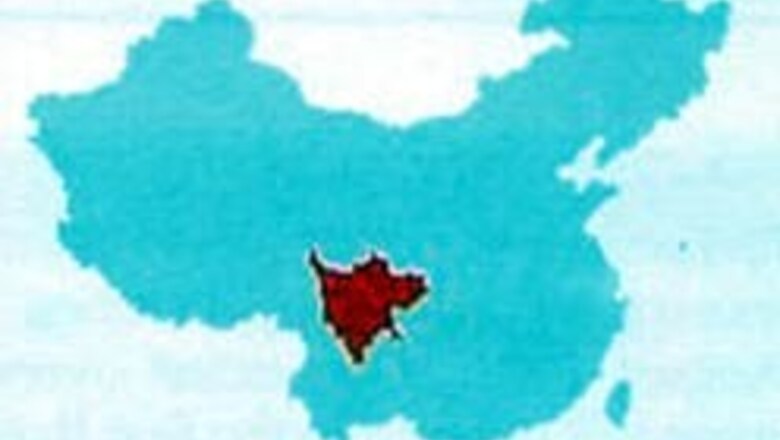
views
China: A construction site in the western suburbs of Chengdu in China's Sichuan province looked much like any other. It all started when a bulldozer driver heard a scraping sound as his machine hit deep into the ground. He struck a collection of golden, jade and bronze objects.
Workers and passers by snapped up the treasures and scurried off. Those too late to get anything, disgruntled, report the find to the police. And that's how, in February 2001, the world learned about the relics of a mysterious 3,000-year-old Jinsha kingdom in the mountains of southwest China.
"Jinsha culture is unique, quite different from cultures in other parts of China, but is scarcely mentioned by Chinese historians," said Zhu Zhangyi, a veteran archaeologist in Sichuan and deputy-curator of the Jinsha Museum. "The harsh geography made it difficult for outsiders to enter the kingdom and so it was able to preserve its endemic culture."
Police have been able to recover most of the relics purloined from the construction site -- about 100 items in all, but no one can confidently claim that they have recovered everything.
In the past six years, the site has yielded up about 6,000 gold, jade, bronze and stone artefacts, tens of thousands of pottery items and also hundreds of elephant tusks.
Jinsha means "gold sand". True to its name, the site has proved extraordinarily rich in gold relics.
"Chinese people typically use gold as jewellery -- earrings, bracelets or necklaces -- but Jinsha people used gold for sacrificial purposes. They made gold masks, gold headware and strange, horn-shaped objects in finely worked gold," said Sun Hua, an archaeologist from Beijing University.
Experts are flabbergasted by the ancient people's skill in making gold artefacts. Two relics in particular showcase their technical prowess.
One is a round foil bearing images of the sun and of four flying birds. The gold foil is only about 0.02 cm thick, the width of a piece of paper, 12.5 cm in diameter and 94 percent pure. Some people have speculated that the twelve lights around the sun represent the twelve months and the four flying birds the four seasons.
"It is just speculation. No one can say for sure what the pictures really mean," Zhu said, "but we do know that the ancient kingdom worshipped the sun and birds."
Another important piece of gold ware is a mask, discovered in February 2007. Sorcerers who communicated with divine forces probably wore the mask. It is 19.5 cm wide, 11 cm long, 0.04 cm thick and weighs 46 grams.
Gold masks were not common in China at that time, but widely used in Egypt and the Middle East.
"Some foreign visitors said the mask reminded them of people in their countries," said Zhao Bisong, a local Jinsha villager and now a security worker at the museum. "It's humbling to realize that our ancestors were able to make such vivid and striking things."
"The similarity in facial features provides clues about exchanges between the Shu Kingdom and areas in western Asia," Zhu added.
Sichuan is known for pandas rather than elephants but despite this, literally tonnes of elephant tusks have been extracted from the site.
Measuring 1.60 meters long on average, with one gigantic 1.85-meter, the elephant tusks are an impressive sight.
"One thing is for sure, they are from Asian elephants. Experts are analysing the tusks to figure out how big the elephants were," Zhu said.
It is not clear what the elephant tusks were used for. A drawing inscribed on a piece of gold ware shows a man on his knees carrying an elephant tusk on his back.
"The elephant tusks must have been used in religious rituals, but we don't know what kind of god the elephant tusks were offered to or how they were used in the rites," Zhu said.
One of the greatest mysteries of Jinsha culture is that it left no written characters, despite the fact that most ancient cultures were already developing and using characters at that time.
"It's very surprising because their culture was quite sophisticated and should have developed characters like other cultures across the world," Zhu said.
"Archaeologists guess they might have written characters on things that did not last, for example leaves or pieces of bark."
Jinsha shares many cultural similarities with Sanxingdui or Three Star Mound - an important archaeological site about 50 km away. Sanxingdui culture disappeared suddenly after about 500 years of existence and some have speculated it may have disappeared in a flood. The discovery of Jinsha suggests that Sanxingdui people may have moved to Jinsha and built another capital there, where their culture lasted for another 500 years before disappearing again.
The Jinsha site covers an area of about five square km.
"As far as we can make out after studying more than 2,000 tombs, the life expectancy of people there was about 30 or 40 years," Zhu said.
The place revealed by the bulldozer was a ceremonial site where the ancient people offered sacrifices to the gods. After the rites, they apparently buried the utensils used during the ceremony in a pit. Each pit holds a minimum of 10 to 20 utensils but some pits used by high-ranking officials or for particularly important gods have as many as 1,000 objects.
Archaeologists are optimistic about more exciting finds.
"The gold masks and jade artefacts carry historical information quite different from cultures in other parts of China," said Sun. "Only half of the 16 layers of deposits have been excavated and further exploration will surely provide new surprises."
"Only about one-tenth of the sacrificial area has been excavated, and the king's mausoleum, which can be expected to contain a rich store of relics, has not been located," said Zhu. "We really have no idea how many relics are lying underground waiting to be discovered."
















Comments
0 comment